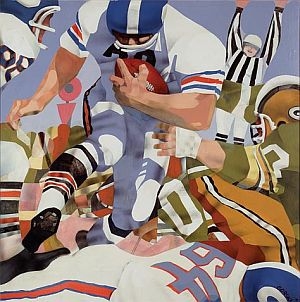
Click here to see images from the Gorski Exhibition
(Host) Just over six months ago, Rutland’s Chaffee Art Center was teetering on the brink, as board members struggled over whether to sell the organization’s historic, but costly headquarters.
The nonprofit voted to stay in its Victorian mansion.
And as VPR’s Nina Keck reports, organizers hope provocative new exhibits like the one that opened last week will help boost attendance.
(Keck) Walk through the sunlit rooms of the Chaffee this month and you’ll get a unique glimpse into the art and psyche of Henry Gorski. Gorski was born in upstate New York in 1918. His work, which spans more than fifty years, has been shown alongside artists like: Andy Warhol and Elaine De Kooning. Mary Mitiguy is the Chaffee Art Center’s Executive Director.
(Mitiguy) "I think this is extraordinary and an incredible opportunity for people in this area to see world class art. Henry Gorski was there with some really big names."
(Keck) Over 100 pieces of art including: oil paintings, bas reliefs, mixed media and sculpture make up the Gorski Retrospective.
(Mitiguy) "The interesting thing is you walk around our building, you feel like you’re looking at a show of several different artists. His art changes. There are some very different styles as you walk through."
(Keck) Henry Gorski is retired now at 91 and no longer paints. He is perhaps best known for his crisp, colorful lithographs of sports figures that he produced in the 1970s and early ‘80s. Hockey fans are still snapping up prints of Black Hawk Goalie and Ice Gods for hundreds of dollars apiece. While his series on athletes look almost like magazine illustrations, many of Gorski’s other works are more provocative, some are downright disturbing. The entire Gorski collection, which is on display at the Chaffee, is owned by Dr. Albert Levis, a psychiatrist and owner of the Wilburton Inn in Manchester. Levis was born in Greece just before World War Two. He first came across Gorski’s artwork in 1972 and was immediately fascinated. As a psychiatrist and educator, he says Gorski’s paintings and sculptures powerfully illustrate human emotions and behavior patterns like conflict resolution.
(Levis) "And so in every room here, we have the artist’s paintings resolving conflict. So you have the beginning which is the conflict and the ending which is the resolution. And in every one of these rooms you have a sense of spiritual discovery and excitement like the artist had."
(Keck) The creative process, says Levis, is like a release valve – providing humans with a way to deal with the difficulties and realities of life. He says Gorski’s paintings are a good example. Levis points to the first in a series that deal with the artist’s anger over the Vietnam War.
(Levis) "And so if you have stress – which you have for instance here with Gorski’s son being drafted to the Vietnam war, then you have an emotional reaction to that and you create all these canvases to find yourself at the end with a conflict resolution the handshake."
(Keck) That last painting shows silhouettes of men in suits shaking hands in front of an American flag. Levis says the paintings reflect how the artist worked through his anger and eventually came to terms with the war. Throughout the exhibit, Gorski’s use of symbolism changes. Raised Catholic, many of his works incorporate his struggle with issues like: faith, guilt, communication and sexuality. Levis says what’s fascinating for audiences is not only seeing the artists’ emotions revealed, but experiencing their own discovery as they take in Gorki’s thought provoking artwork.
For VPR News I’m Nina Keck in Rutland.
Note: The exhibit will be on display at the Chaffee Art Center in Rutland through October 12th.